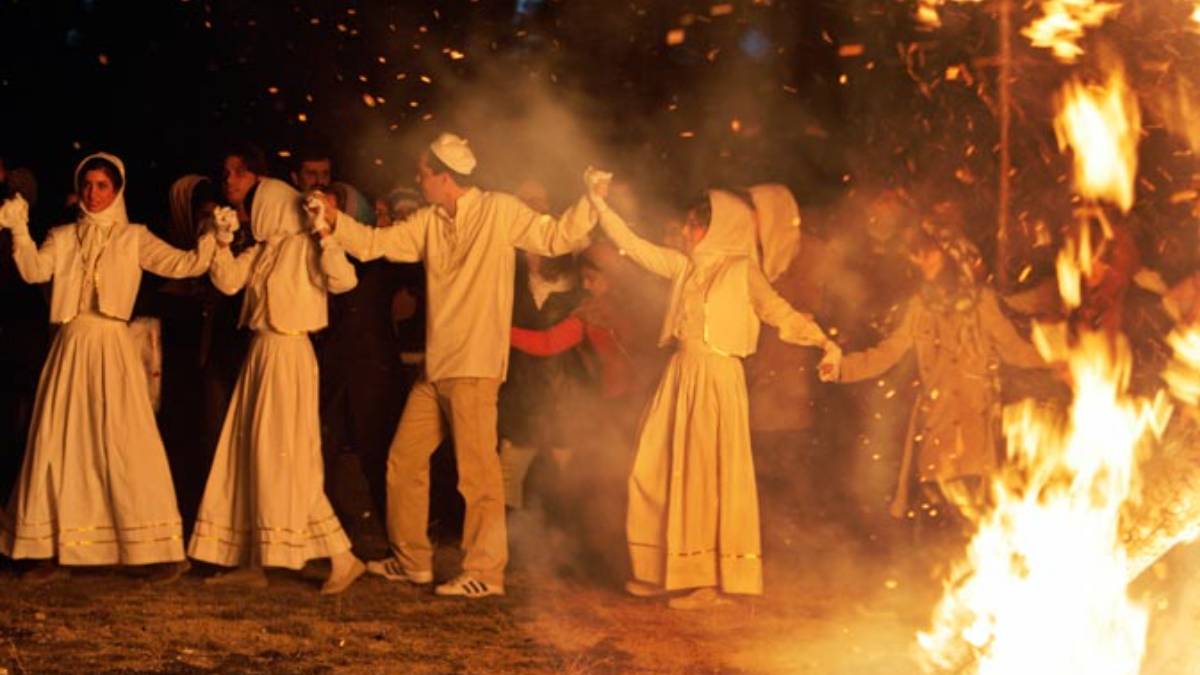di Setareh Keyhani
Negli ultimi anni, le vivaci celebrazioni dell’antico Iran sono diminuite, in gran parte a causa di interferenze governative che cercano di sopprimere le pratiche religiose storiche del paese attraverso misure restrittive.
Un punto di svolta notevole si è verificato con l’ascesa del movimento ”Donne, vita, libertà”, incoraggiando i cittadini a sfidare i vincoli del governo. Le persone hanno dimostrato coraggio opponendosi apertamente alle restrizioni imposte dalla poltica, con un’attenzione significativa alla salvaguardia delle antiche feste e rituali iraniani, celebrati a pieno splendore.
Un evento esemplare in questa lotta è l’osservanza del Sadeh Festival, una celebrazione tradizionale che si tiene in occasione dell’imminente arrivo della primavera, vietato dal governo. In un simbolico conto alla rovescia per il Nowruz (il Capodanno persiano, n.d.r.) i festeggiamenti di Sadeh iniziano 50 giorni prima, incorporando antichi rituali dedicati al fuoco, che simboleggiano il trionfo sulle tenebre, il gelo e il freddo.
Quest’anno, una grande folla ha sfidato il divieto di danzare pubblicamente; ritrovatesi in strada, ornate di costumi locali, le persone hanno praticato balli tradizionali per celebrare il Festival di Sadeh. Nonostante sia stato recentemente riconosciuto dall’UNESCO come patrimonio umano intangibile, il governo è intervenuto sopprimendo il festival, mostrando la sua avversione per l’osservanza su larga scala delle più antiche tradizioni iraniane.
Mentre la Repubblica islamica dell’Iran persegue attivamente l’istituzione di un regime islamico, i cittadini si stanno sforzando di mantenere la loro identità difendendo le tradizioni e sfidando il governo, sempre più incline a contrastare l’organizzazione di cerimonie pubbliche ed eventi religiosi.
Storicamente, l’inverno si è concluso con i festival invernali, con un passaggio di continuità ai continuità ai festival primaverili che annunciano il nuovo anno. L’ingresso dell’Islam in Iran ha portato la trasformazione di queste celebrazioni, con ulteriori limitazioni imposte dopo la rivoluzione. Abbigliamento locale, colori, danze tradizionali, cibi locali e musica erano parte integrante di queste cerimonie, e riflettevano il ricco arazzo dell’identità iraniana. Ma, anni di restrizioni hanno spinto il popolo a confrontarsi con il governo, sforzandosi di far rivivere antiche tradizioni e celebrazioni.
Indubbiamente, recuperare il patrimonio culturale iraniano dalle grinfie della Repubblica islamica dell’Iran pone delle sfide, che però necessitano una scelta risoluta da parte del popolo per plasmare il loro futuro e riprendere il controllo sulla loro vita, forti contro le politiche restrittive della Repubblica islamica dell’Iran.
English version
Iranians Take Back Their Culture
Although the position of the Islamic Republic of Iran about the Iranian culture is clear, Iranian people try to take back their cultural identity and their traditions. The more the Islamic Republic of Iran tries to change the culture, the more people try to celebrate their traditions.
by Setareh Keyhani
In recent years, the vibrant celebrations of ancient Iran have waned, largely due to governmental interference seeking to suppress the country’s historical religious practices through restrictive measures.
A notable turning point occurred with the rise of Women, Life, Freedom movement, emboldening citizens to defy the government’s constraints. People demonstrated courage by openly opposing governmental restrictions, with a significant focus on safeguarding ancient Iranian festivals and rituals, celebrated with full splendour.
An exemplary event in this struggle is the observance of the Sadeh Festival, a traditional celebration held to mark the imminent arrival of spring, forbidden by the government. In a symbolic countdown to Nowruz, the Persian New Year, Sadeh festivities commence 50 days prior, incorporating ancient rituals dedicated to fire, symbolising triumph over darkness, frost, and cold.
In a surprising turn of events this year, a massive crowd defied the ban on public dancing, taking to the streets adorned in local costumes, and engaging in traditional dances to celebrate the Sadeh Festival. Despite being recently recognised by UNESCO as an intangible human heritage, the government intervened, suppressing the Sadeh Festival, showcasing its aversion to the large-scale observance of Iranian traditions.
While the Islamic Republic of Iran actively pursues the establishment of an Islamic Iran, citizens are striving to maintain their Iranian identity by adhering to time-honoured traditions. The government’s inclination towards organizing mourning ceremonies and religious events starkly contrasts with the public’s yearning for happiness and celebration.
A constant source of tension arises from the government’s attempts to undermine the authenticity and identity of the Iranian people, particularly concerning ancient Iranian ceremonies. Despite the failed efforts to alter the name of a significant religious ceremony last year, the public’s resistance against government-imposed restrictions on their cultural heritage remains unwavering.
Historically, winter concluded with winter festivals, seamlessly transitioning into spring festivals heralding the Iranian New Year. Islam’s entry into Iran led to transformations in these celebrations, with further limitations imposed following the Islamic Revolution. Local clothing, diverse colours, traditional dances, local foods, and music were integral components of these ceremonies, reflecting the rich tapestry of Iranian identity. However, years of restrictions prompted the people to confront the government, striving to revive ancient traditions and celebrations.
Undoubtedly, reclaiming Iran’s cultural heritage from the clutches of the Islamic Republic of Iran poses challenges. Yet, it signifies a resolute choice by the people to shape their future and regain control over their lives, standing against the restrictive policies of the Islamic Republic of Iran.
